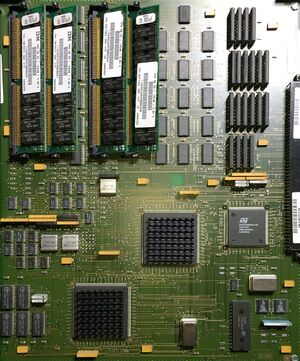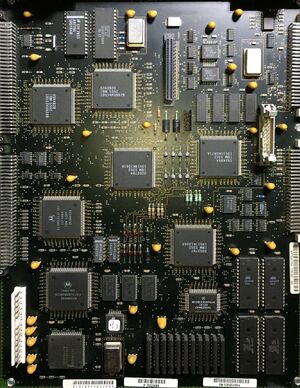9401-P03
The IBM AS/400 9401 Model P03 is a comparatively tiny model. It's still a CISC processor machine, despite having a black case.
Maximum Memory
The available documentation in the CISC System Builder Redbook might appear a bit confusing.
There is a table showing different Packages of the P03 hardware with different amounts of maximum RAM on PDF page 8. The ordinary P03 has 8 MB soldered to the main board, and features four PS/2 SIMM slots. SIMMs must be added in pairs of two equal SIMMs. The table on PDF page 9 shows features #3117 (two 4 MB SIMMs) and #3118 (two 8 MB SIMMs) only for certain packages. Each of them with a maximum of two. All of these Packages have in common to max out below 56 MB.
PDF page 10 shows features #3159 (two 4 MB SIMMs) and #3160 (two 8 MB SIMMs). The latter with a maximum of three. Since the "stock" board only has four SIMM slots, the board accommodating up to 56 MB RAM must be physically different, and has to have two additional SIMM slots.
Tweaks
Things not originally intended by IBM.
Noise
There's not much physical space to lessen its noise emissions by applying dampening pads to the case, or stuffing with noise absorbing material. A little relief can be achieved by disassembling it completely to extract the PSU. You need to drill out the rivets and search for some matching screws in your collection. The fan can be made a bit less noisy with a 27 Ω resistor put in series. Don't expect wonders, though.
Note! 33 Ω or higher values trigger some fan observing circuitry on the PSU board. If it triggers, you'll get the amber LED on front and a SRC 00000003 in the display, after the PSU shut down. This happens within the first few seconds of power on.
The original fan fas ball bearings but for unknown reasons, the visible bearing emitted an awful rattling noise. Removing the sticker showed dark smear. Using solvent, I finally could identify this as grease-rust mixture. Since I couldn't remove the snap ring keeping the rotating part of the fan in place, I could not access the inner bearing and chose to exchange the 92 mm fan with a newer, high-quality model with also 25 mm thickness. The machine is much quieter now, even without a resistor. Note, this is a major undertaking. It requires time, patience and creativity because of the way the fan has been locked in place through bent parts of the PSU case.
Weblinks
- AS/400 CISC System Builder, PDF
- IBM Application System/400 Advanced Portable Models Sales Manual, IBM
- IBM AS/400 9401 Portable (Model P03), supervinx.com
- IBM AS/400 9401 Portable (Model P03) with InfoWindow II, supervinx.com

